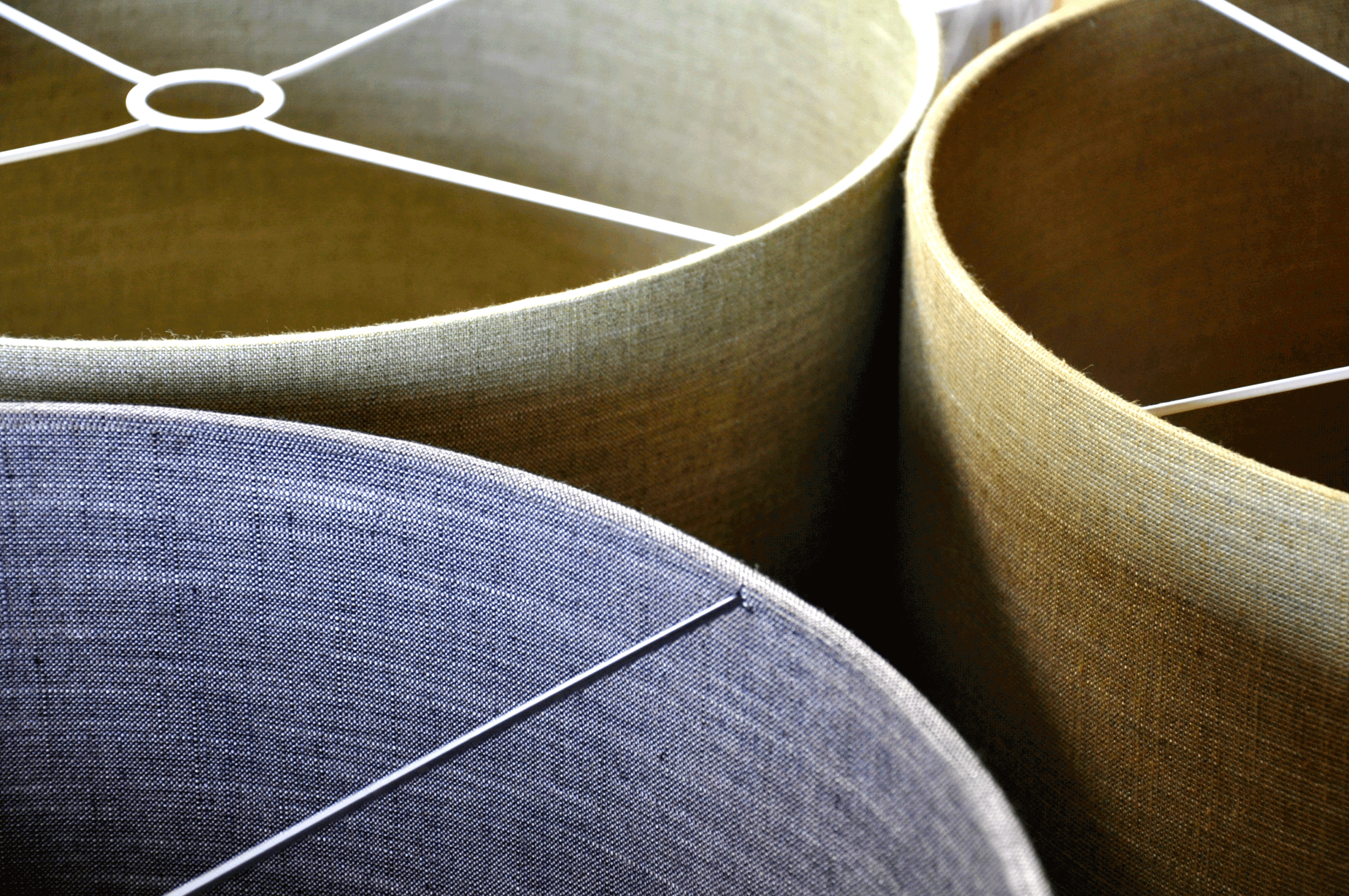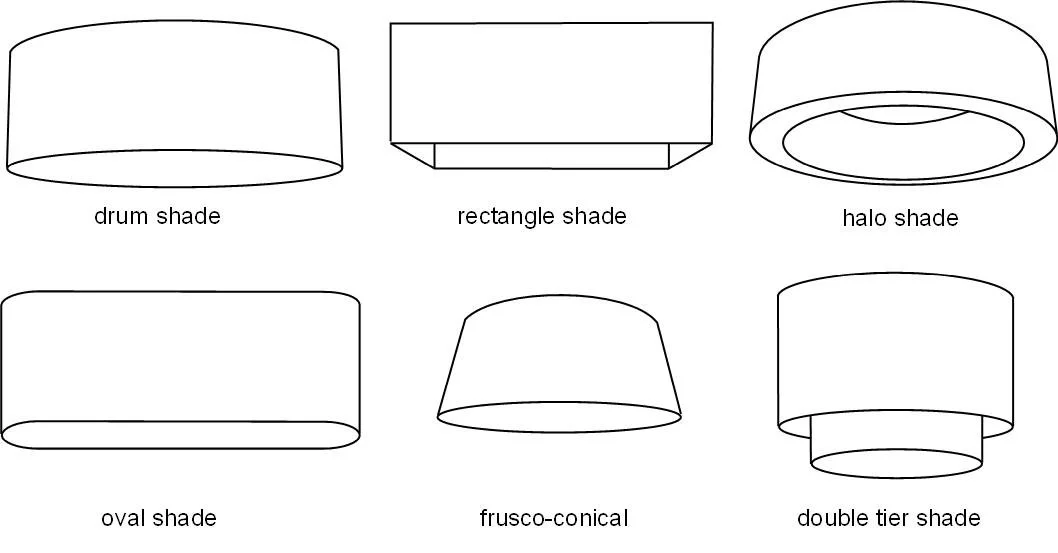
Frequently Asked Questions
-
The material you would like to use, or let us help you find something for you.
Provide the size (dimensions) of the lamp shade and its orientation:
top and bottom diameter, height, and if it is a pendant (hanging) lamp shade or a table/ floor lamp shade.Ask us or calculate the fabric you have chosen to see if it is sufficiently long or wide enough to go around the lamp shade.
Length of fabric required (millimeter) = diameter of lamp shade (millimeter) x 3.3
Height of fabric required (millimeter) = height of lamp shade + 60mmFor conical lamp shades, we have a inhouse app that can calculate the exact fabric amount required.
Provide us with the orientation of the fabric on the lamp shade.
And then please provide the delivery address.
-
Our standard shapes that we make are:
Drum lamp shades
Conical lamp shadesWe can make custom made frames is you have a special shape that you have your eye on, such as square, rectangle, or tapered square and rectangle.
-
These are the size lamp shade frames that we use to make lamp shades.
100mm
150mm
200mm
250mm
300mm
330mm
400mm
500mm
600mm
800mm
1000mm
-
If you’re having a lampshade made specially (custom size, fabric, shape, etc.), here are typical lead‑times and things to expect.
Q: What is a typical lead time for bespoke lampshades?
A:We generally aim for 1 week from receiving the chosen fabric or wallpaper and we have the required lamp shade frame in stock. Allow for a few extra days for shipping your lamp shade to you.
4‑6 weeks for fully bespoke handmade lampshades when we have to make a large diameter frame or the frame is not in stock. Typically these are lamp shades larger than 500mm.
Q: Why does it take so long?
A:
Because bespoke involves: choosing or sourcing fabric/material, cutting and constructing a custom frame or size, finishing trims, quality‑checks, shipping, etc. Each step depends on materials and craftsmanship.
Q: What should I ask/make sure of when ordering bespoke?
A:Confirm the lead time.
Provide the size dimensions of the lamp shade and the orientation: top and bottom diameter, height, and if it is a pendant (hanging) lamp shade or a table/ floor lamp shade.
If you are supplying your own fabric, please send it to us. If you require help with sourcing fabric, we can assist you and order it for you.
Ask us or calculate if the fabric you have chosen is sufficiently long or wide enough to go around the lamp shade:
Length of fabric (in millimeter) = diameter (in millimeter) x 3.14When the fabric you have chosen has a non-directional pattern, then the length of the fabric is either the width of the fabric for smaller lamp shades, or up the roll on larger lamp shades. For directional patterned fabric, we can pattern match with a small seam if the fabric width in not wide enough. For larger lamp shades this is how we solve having the pattern orientated in the right direction.
Provide the orientation of the fabric on the lamp shade.
Confirm if you want fabric or wallpaper on the inside of your lamp shade.
Confirm lamp holder type: Generally in New Zealand we use the larger E27 Edison screw lamp holder and the smaller B22 bayonet lamp holder. We will supply an adapter with each lamp shade.
Bespoke lamp shades are non‑returnable once work begins.
-
Q: What material can I choose on my custom lampshade?
A: Here are general guidelines:Cotton materials are easiest to work with when making a custom lamp shade. This can be thin or thicker cottons.
We often work with silk and other delicate fabrics. It takes a bit more time to make but we still love making your lamp shades.
We often work with velvet fabric.
Generally, all wallpapers are fine to make into a lamp shade.
Thicker fabric material such as velvet and some wallpapers will not let light through so take this into consideration when deciding on what fabric or wallpaper to use.
-
Q: What size lamp shade do I need for my lamp base?
A: Here are general guidelines:For table lamps:
The height of the lamp shade should be about three‑quarters to the height of the base.
The bottom diameter of the lamp shade should roughly equal the height of the table lamp base (the distance from table top up to the fitting of the lamp shade) or be about twice the width of the lamp base.For floor lamps:
the lamp shade bottom diameter often starts around
~450mm (18″) or larger. A 500mm diameter Frangipani
lamp shade looks fabulous on a timber floor stand.Avoid a lamp shade that’s narrower than the widest
part of the lamp base, and don’t let the socket or harp
show.
Q: What size lamp shade do I need for my ceiling?
A: The bigger the lamp shade, the more pronounced the statement piece will be. We generally advice to go bigger than you think possible for the room.
Q: Are these rules set in stone?
A: No ‑ they’re helpful guidelines. If you prefer a dramatic or oversized look, you can break the rules—but being too small usually looks off. -
Typical measurements:
Top diameter (A)
Bottom diameter (B)
Slant height (C) if it’s tapered
Vertical height (D) from top to bottom.
Also: measure your lamp base height, width, and where the shade will sit to ensure good proportion.
-
Q: Does the lamp shade affect which bulb I should pick?
A: Yes, indirectly. The shade’s material, openness, and how much light you want make a difference. Here are tips:We recommend using a warm white for ambience.
Use a higher wattage bulb when you require a lot of light and a lower wattage bulb when looking for ambient and mood lighting.
Thicker fabric material such as velvet and some wallpapers will not let light through so take this into consideration when deciding on what fabric or wallpaper to use.
If you are looking for mood lighting, then a thick material is just what you are after.
Some bespoke lamp shades give a max‑wattage recommendation.
Q: Can I use any shape bulb?
A: Generally yes, provided the bulb fits the socket and the shade allows clearance around the bulb so that heat can dissipate. If you use a higher‑wattage bulb, ensure the shade isn’t too snug. -
Q: How often should I clean a fabric or wallpaper lampshade?
A:Every 3‑6 months or when visibly dirty: especially if in kitchen, near a window or in dust‑prone area.
check for spots/stains and do a more thorough clean depending on location.
Q: What’s the safe cleaning method for fabric or wallpaper lampshades?
A:Unplug the lamp and remove the shade.
Fabric lamp shades: use a soft brush, lint roller, or low‑suction vacuum‑brush. Avoid soaking with water as the fabric will most likely stain. Contact us if you want us to clean your lamp shade. info@joug.co.nz
Wallpaper lamp shades: using mild soapy water and a soft cloth and gently remove a spot or stain, avoid rubbing too hard as it will damage the wallpaper.
The inside white backing material of a fabric or wallpaper lamp shade can be cleaned using a damp cloth and a bit of liquid soap. Do not soak as the water may stain the fabric material on the outside and undo the seam in the lamp shade.
Dry thoroughly in a well‑ventilated area; do not re‑install until entirely dry.
Q: Any special tips if the shade has pleats or made with velvet?
Yes:
For pleated or gathered fabric: Clean in the direction of the pleats using a soft brush; avoid strong suction/vacuum to prevent damage.
Avoid placing in direct sunlight or high humidity, as fabric/faded prints can deteriorate.
Stroke the velvet in a downward direction to remove any unsettling of the velvet material.
-
A: If a shade is broken, yellowed, brittle, or the lining is deteriorating, cleaning may not suffice and replacement might be the better option. At Joug Design, we often remake loved lamp shades to look like new again.
-
Be sure to remove the lamp shade from the lamp holder before cleaning
You can clean the lamp shade range made from the white material, using mild soapy water and a soft cloth and gently remove a spot or stain (Frangipani, Seacloud, Seafower, white Urchin).
For suborn stains these lamp shades can be spot cleaned using methylated spirits.
The bamboo veneer lamp shades can be cleaned with an eraser or a damp cloth. Too much water will delaminate the bamboo veneer.
If you would like us to clean or repair your lamp shade, please contact us. info@joug.co.nz
-
Return Policy
Joug Design Return Policy
At Joug Design, we stand behind the quality of our work and want you to be completely satisfied with your purchase.
100% Satisfaction Guarantee
We offer a 100% satisfaction guarantee for all designs made by Joug Design, including the Frangipani, Seaflower, Seacloud, Urchin and Puawai lamp shades. If you are not entirely happy with your purchase, please contact us within 10 days of receiving your item to discuss a return, exchange, or refund.
Custom-Made Items (Customer-Supplied Material)
Due to the personalized nature of our custom made lamp shades, specific conditions apply to items where you provide the covering material:
Items Affected: This applies to custom fabric and wallpaper lampshades where the material is supplied by the customer.
Remedy Only: These custom items cannot be refunded because they are uniquely made to your specifications using your materials.
Faulty Workmanship: If the lampshade has a fault due to an error on our part (Joug Design), we will fix, remedy, or replace the item at no extra cost to you. We guarantee our workmanship.
How to Initiate a Return or Remedy
To start a return or report an issue with your order, please follow these steps:
Contact Us: Email us at info@joug.co.nz or on the contact form found at the bottom of our home page.
Provide Details: Please include your order number, a description of the item you wish to return, and the reason for the return or the nature of the fault.
Return Shipping: We will provide instructions on how to send the item back to us. If the return is due to a fault in our workmanship, we will cover the return shipping costs.
General Conditions
Condition: Items must be returned in their original condition and packaging (where applicable) unless a fault is present.
Proof of Purchase: A receipt or order number is required for all returns and inquiries.
We are committed to resolving any issues fairly and promptly. Please contact us with any questions about our policy.



